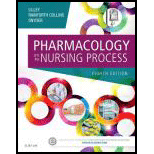
(1)
To determine:
T.E.’s mother asks, “Why is the antibiotic a pill? It seems to me that if she has an ear infection, she should take eardrops!” What is the nurse’s best response?
Case summary:
T.E. is an 8-year-old girl who loves swimming. In her left ear, she had a fullness feeling and told her mother that her ear is itching and hurting. Her mother noted her temperature at 101° F (38.3° C). Her mother took her to the office and after examining T.E., the pediatrician said that T.E. has otitis media in her left ear and earwax buildup in both the ears. Manually, the pediatrician removed some earwax and prescribed oral antibiotics and earwax emulsifiers. The nurse met them to review the instructions.
(2)
To explain:
T.E.’s mother has another question: “What will happen if this ear infection does not get better?”
Case summary:
T.E. is an 8-year-old girl who loves swimming. In her left ear, she had a fullness feeling and told her mother that her ear is itching and hurting. Her mother noted her temperature at 101° F (38.3° C). Her mother took her to the office and after examining T.E., the pediatrician said that T.E. has otitis media in her left ear and earwax buildup in both the ears. Manually, the pediatrician removed some earwax and prescribed oral antibiotics and earwax emulsifiers. The nurse met them to review the instructions.
(3)
To determine:
T.E. complains that her ear “really hurts and itches.” What can be given to her for this problem? How will it be given?
Case summary:
T.E. is an 8-year-old girl who loves swimming. In her left ear, she had a fullness feeling and told her mother that her ear is itching and hurting. Her mother noted her temperature at 101° F (38.3° C). Her mother took her to the office and after examining T.E., the pediatrician said that T.E. has otitis media in her left ear and earwax buildup in both the ears. Manually, the pediatrician removed some earwax and prescribed oral antibiotics and earwax emulsifiers. The nurse met them to review the instructions.
Want to see the full answer?
Check out a sample textbook solution
Chapter 58 Solutions
Pharmacology and the Nursing Process, 8e
- true or false any practice employee is authorized to and should communicate collection guidelines with practice?arrow_forwardrtrue or false equesting a listing of specific creditreferences during patient intake os an acceptable business practice?arrow_forwardgive an overview on the respiratory assessmentarrow_forward
- explain an abdominal exam?arrow_forwardDiscuss β -Lactam antibiotics under the following subheadings Classifications of penicillins Classification of Cephalosporins General Mechanism of Actions Clinical Indications of penicillins and cephalosporins Adverse effects of β-lactamsarrow_forwarda. Define neoplasm b. Differentiate between benign and malignant tumours c. Describe the molecular basis of cancerarrow_forward
- differentiate the extra heart sounds S3,S4, murmurs and gallopsarrow_forward• Define shock and list types of shock • Discuss pathogenesis of septic shock. • Enumerate the stages of shock. • Define oedema and describe the pathophysiologic mechanisms of oedema with examples.arrow_forwardDiscuss Hypertension under the following headings: Definition Diagnosis Non-pharmacological intervention Drugs Classification Management of a Hypertensive emergencyarrow_forward
- Explain how the answer could be 2 or 1.8 WITHOUT changing the questionarrow_forwardoverview of the neurological system, cranial nerves and what part of the body it innervatesarrow_forwarddifferentiate structure and function of the peripheral vascular system. what are the normal and abnormal findings of the peripheral arterioles and peripheral venous systemarrow_forward
 Phlebotomy EssentialsNursingISBN:9781451194524Author:Ruth McCall, Cathee M. Tankersley MT(ASCP)Publisher:JONES+BARTLETT PUBLISHERS, INC.
Phlebotomy EssentialsNursingISBN:9781451194524Author:Ruth McCall, Cathee M. Tankersley MT(ASCP)Publisher:JONES+BARTLETT PUBLISHERS, INC. Gould's Pathophysiology for the Health Profession...NursingISBN:9780323414425Author:Robert J Hubert BSPublisher:Saunders
Gould's Pathophysiology for the Health Profession...NursingISBN:9780323414425Author:Robert J Hubert BSPublisher:Saunders Fundamentals Of NursingNursingISBN:9781496362179Author:Taylor, Carol (carol R.), LYNN, Pamela (pamela Barbara), Bartlett, Jennifer L.Publisher:Wolters Kluwer,
Fundamentals Of NursingNursingISBN:9781496362179Author:Taylor, Carol (carol R.), LYNN, Pamela (pamela Barbara), Bartlett, Jennifer L.Publisher:Wolters Kluwer, Fundamentals of Nursing, 9eNursingISBN:9780323327404Author:Patricia A. Potter RN MSN PhD FAAN, Anne Griffin Perry RN EdD FAAN, Patricia Stockert RN BSN MS PhD, Amy Hall RN BSN MS PhD CNEPublisher:Elsevier Science
Fundamentals of Nursing, 9eNursingISBN:9780323327404Author:Patricia A. Potter RN MSN PhD FAAN, Anne Griffin Perry RN EdD FAAN, Patricia Stockert RN BSN MS PhD, Amy Hall RN BSN MS PhD CNEPublisher:Elsevier Science Study Guide for Gould's Pathophysiology for the H...NursingISBN:9780323414142Author:Hubert BS, Robert J; VanMeter PhD, Karin C.Publisher:Saunders
Study Guide for Gould's Pathophysiology for the H...NursingISBN:9780323414142Author:Hubert BS, Robert J; VanMeter PhD, Karin C.Publisher:Saunders Issues and Ethics in the Helping Professions (Min...NursingISBN:9781337406291Author:Gerald Corey, Marianne Schneider Corey, Cindy CoreyPublisher:Cengage Learning
Issues and Ethics in the Helping Professions (Min...NursingISBN:9781337406291Author:Gerald Corey, Marianne Schneider Corey, Cindy CoreyPublisher:Cengage Learning





